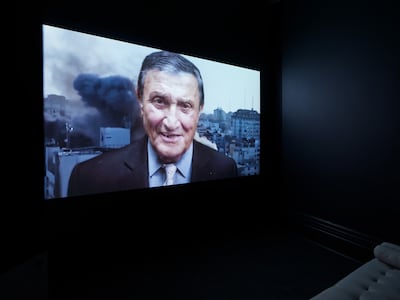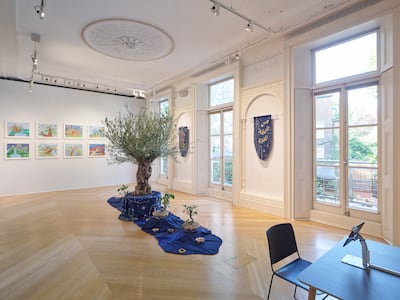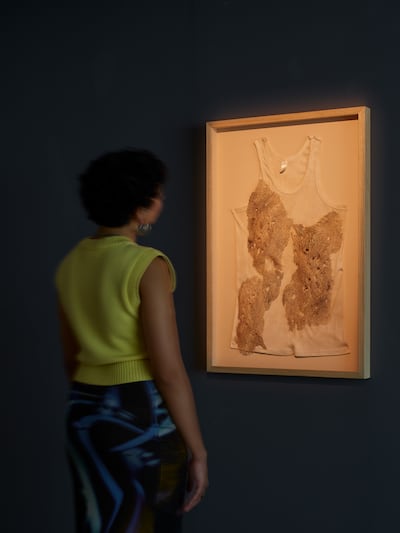An exhibition of new commissioned pieces by four young Palestinian artists has just opened in London’s Mosaic Rooms. In the Shade of the Sun is multidisciplinary and multilayered, ranging from film to ceramics, and from the political to the poetic.
The artists were brought together as part of the Bilna’es project, a platform created by established artists Ruanne Abou-Rahme and Basel Abbas to support artistic communities in Palestine and the diaspora. Three of the four artists were present at the opening of the exhibition; only electronic musician Makimakkuk, whose sound work was due to be performed, couldn’t make it due to visa problems and will come in October instead.
The first room features a short film by Mona Benyamin that uses the medium of a news broadcast, but one that is narrated through grand emotional displays, gestures and heated arguments.

Newsreaders are reduced to crying their way through a segment instead of speaking; TV journalists and interviewees scream at one another; witnesses have wildly differing stories; and a weather forecaster laughs unnervingly while images of conflict in Palestine appear behind him, spanning from the Nakba to present day.
“The medium of TV news has become tied to a form of truth when in reality it’s one of the most dramatised formats I have encountered,” explains Benyamin during a tour of the exhibition shortly after its opening. It’s also a format where the “images are meaningless without the spoken narrative”, she adds.
Benyamin turned to her own family members – mother, father, an uncle and a cousin – as actors for the video. Their constant reappearance in many different roles becomes a form of commentary on the endless and all-consuming cycle of violence and trauma that Palestinians live with, highlighting the tropes of conflict reporting that appear to flatten the subject matter despite the tragedies depicted. It also reflects the impossibility of reporting with emotional detachment on a subject that affects one so personally.

Xaytun Ennasr’s contribution is a multimedia installation called Revolution is a forest that the colonist can’t burn, which centres on the tree as a symbol of resistance and devotion. At the heart of the space is a beautifully gnarled 125-year-old olive tree (sadly not from Palestine due to restrictions) and two small fig trees that sit on a drape of embroidered fabric on which ceramic bowls are placed as “offerings”.
On the walls a series of drawings of trees seem to come alive against slightly surreal backdrops. With this project Ennasr wanted to explore what a “revolutionary relationship to nature outside of extraction, subjugation and domination could be; one based on love, tenderness, stewardship and living with the world rather than controlling it” – referring to this aesthetic as “radical softness”.
A video game developed in collaboration with Ennasr's brother takes this notion further, highlighting how landscapes and trees in video games are depicted almost exclusively as a resource to be extracted or colonised, or an obstacle to be destroyed. Instead, this game encourages visitors to fill a virtual landscape with trees that, as the exhibition progresses, will become a forest. It’s a compelling invitation to use the digital world as a space where new and “revolutionary” relationships with the natural world can be experimented with.

Downstairs a film by Jerusalem artist Dina Mimi runs in two chapters on different screens concurrently, and links the idea of the smuggler and the fugitive – of migration and escape routes – with birds as an intriguing central protagonist and leitmotif.
One screen focuses on the bird smuggling that takes place between Jordan and Palestine, while the other shows, in grainy 16mm film, songbird competitions in Amsterdam run by the Suriname community whose birds come from China via the South American country.
During the making of the piece, Mimi was fascinated with the story of the six Palestinian prisoners who had managed to escape a high-security facility in northern Israel in September 2021. She connects these bigger themes to a personal story of loss as a child, when a close friend moved away to another city.
“Proximity of distance does not mean ease,” she states in a melancholic voice-over. She seeks out this same friend years later and finds before her an intellectual and political revolutionary, but one with no real life experience. It is hard to be a revolutionary when you have everything to lose she remarks, when “your first mistake will be your last”.
In the Shade of the Sun runs at Mosaic Rooms, London, until January 14; mosaicrooms.org
